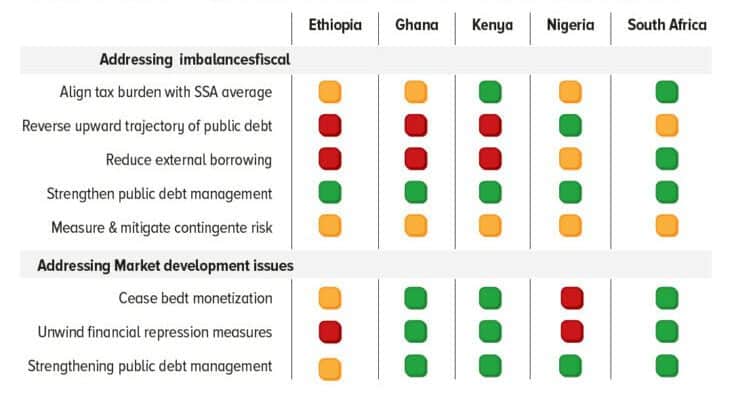To understand the challenges to debt sustainability and financial market development posed by Covid-19 and the war in Ukraine, FSDA recently completed a study of the experience of five case-study countries: Ethiopia, Ghana, Kenya, Nigeria, and South Africa.
Chronic fiscal and current account imbalances had arisen well before the Covid-19 pandemic, already severely hampering the ability of country authorities to respond to unexpected shocks.
Counter-cyclical fiscal measures in response to Covid-19 then led to the accumulation of even higher levels of public debt. Even though all countries are exposed to liquidity and solvency risks, debt simulations show that the most important risk to be monitored is the risk of external debt distress.
The availability of foreign exchange required to fund current account deficits and the servicing of external debt is constrained by low public sector revenues and large trade deficits. Prospects for alleviating such liquidity pressures in the short to medium term are limited, as they depend on structural changes aimed at reducing current account deficits.
Indeed, it is anticipated that these pressures will become even more acute in 2022/2023 due to rising interest rates on external borrowing. With the tightening of credit markets worldwide and yields at historically high levels, Ghana, Kenya and Ethiopia are particularly exposed, as they face sizable refinancing risks on their Euro-borrowing.
Nigeria and South Africa are in a less precarious situation than the other three countries. Nigeria entered the Covid-19 crisis with a lower level of public debt while South Africa’s deep domestic financial market makes it possible to absorb higher levels of public debt. However, even with its more developed taxation system, South Africa is also exposed to liquidity risk, as reliance on foreign portfolio investment in domestic government debt exposes South Africa to risk, due to the ‘vagaries’ of foreign portfolio investors.
Table 1 below gives an overview of the gravity of the liquidity and solvency risks facing the five-country case studies explored in this paper:

In responding to the Covid-19 pandemic, governments adopted a combination of policy responses to mitigate the negative impact of increased government borrowing: (a) reducing policy interest rates, (b) central bank purchases of long-term government bonds and sale of short-term securities (quantitative easing) in Ghana and South Africa, (c) drawing on central bank overdraft facilities or financing government expenses by issuing securities directly to the central bank (debt monetisation) in Ethiopia, Nigeria and Ghana; and (d) relying on financial repression measures, such as foreign exchange controls, payment of negative real interest rates on government securities, and the imposition of investment requirements on banks and institutional investors in Ethiopia and Nigeria.
Increased domestic borrowing
Since it is very unlikely that governments will implement required fiscal consolidation measures in the near term, it is expected they will need to resort to increased domestic borrowing, and under current macroeconomic circumstances, increased reliance on government debt issuance is likely to put upward pressure on the yield of government securities, thereby crowding out the supply of credit to the private sector.
Under these circumstances policies designed to increase the absorptive capacity of domestic securities, and markets have an important role to play. Debt managers can contribute to this process by ensuring that debt instruments are best tailored to the needs of the domestic and external investor base.
It is in this context that it is important that countries, such as Nigeria and Ethiopia, cease central bank financing of government deficits
Equally important is that domestic money and primary markets have sufficient depth to absorb liquidity shocks as well as the issuance of large volumes of government securities on the primary market.
The more debt issuance by the government is tailored to meeting the needs of a diversified institutional investor base – both the needs of domestic investors and foreign portfolio investors buying domestic securities the needs of foreign investors buying securities issued by the government externally (on the Euro-market) – the more government debt financing costs will be shielded from sudden changes in market sentiment.
Risks and challenges
Nonetheless, the deepening of domestic financial markets presents risks and challenges. Not only will the authorities need to demonstrate their commitment to market-conform policies – aborting policies such as financial repression and excessive monetary financing – but they will also need to prioritise the management of public debt with a view to fostering market development and minimising crowding out that reduces the availability and raises the cost of private sector credit.
There is evidence that, in the short term, increasing the supply of government securities tends to put upward pressure on the sovereign yield curve, thereby raising the cost of borrowing both to the government and the private sector. Increases in the sovereign credit risk premium will also tend to raise the cost of capital for private issuers.
It is in this context that it is important that countries, such as Nigeria and Ethiopia, cease central bank financing of government deficits both to lessen inflationary pressures and to re-confirm commitment to the primary mandate of central banks in controlling inflation.
Even though financial repressive policies, such as requiring investors (banks and institutional investors) to purchase government securities used in Ethiopia and exchange controls as relied upon by Nigeria and Ethiopia may curb the growth of public debt in the short term, they discourage the formation of savings and encourage financial disintermediation in the medium term.
By lessening market responses or introducing market distortions, repressive financial policies reduce immediate responses to shocks in terms of market signals, but at the cost of reducing confidence in market-based finance. Over time, such distortions undermine the role of financial markets in allocating scarce resources to their optimal uses and may be difficult to unravel, as they are associated with opportunities for rent-seeking
Short-term tension
Nonetheless, in making these recommendations, it is important to recognise that adoption of policies designed to support market development will give rise to tradeoffs. In the short term, there are tensions between the gains associated with market development and fiscal costs and risks.
Policies like discontinuing financial repression and refraining from monetary financing while supportive of the financial market development will oblige the governments to find alternative funding sources. Such short-term costs may hamper the authorities’ willingness to implement policy reforms, even when the benefits associated with fostering financial market development, particularly in terms of enhancing the sustainability of the government’s debt, substantially outweigh the costs in the medium to longer term.
Implementing the conditionalities associated with debt relief negotiations more effectively than in the past will be important
In addition, authorities may be hesitant to undertake the transition towards more market-conform financing of their fiscal deficits, as the transition will inevitably raise awareness, transparency, and accountability regarding their funding.
Going forward, implementing the conditionalities associated with debt relief negotiations more effectively than in the past will be important in avoiding a situation where the benefits of debt relief once again only remain temporary. Anticipated external debt levels pose a threat to debt sustainability in four case-study countries, and in the case of South Africa, foreign portfolio investment poses a risk to macroeconomic stability.
Short-lived efforts
Previous attempts to ease the adjustment process and at the same time provide the opportunity for market development have involved debt relief and increased access to external concessional financing. Such debt relief efforts have been accompanied by conditionalities designed to put countries on a path of fiscal consolidation and stabilisation of their external debt positions aimed at ensuring debt sustainability in the future.
However, as documented in this paper, the outcomes of efforts to avoid future debt accumulation and the dangers to debt sustainability were short-lived. Although well-intentioned, these efforts failed to resolve macroeconomic imbalances, and countries were ill-prepared to meet recent shocks.
Table 2 provides an assessment of the severity of the policy challenges faced by the five case-study countries in addressing fiscal imbalances and supporting market development.

Read original article



